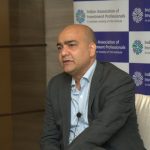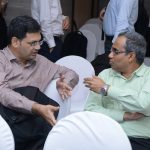- August 30, 2017
- Posted by: annlin@india.cfasociety.org
- Category:BLOG, Events, New Delhi, Workshop
Contributed By- Shivani Chopra, CFA

CFA Society India and EY LLP jointly organised a two day workshop in Delhi on Aug 4th and 5th on the topic – “Advanced Modelling and Valuation”. Similar workshops were conducted in Mumbai (2016) and Bengaluru (Feb 2017). The event in Delhi was equally successful with around 50 attendees learning one of the crucial skills to strive for excellence in valuation related roles. Designed by industry experts, the program combined core concepts with applied tools for participants. Star speakers included Mr. Navin Vohra (Partner, Ernst & Young) & his team, from CFA Institute- Mr. Robert Gowen, CFA (Head, Product Solutions, CFA Institute) and Mr. Shreenivas Kunte (Director, Continuing Education and Advocacy, India, CFA Institute), Sampath Reddy(CIO, Bajaj Allianz Life Insurance), Anil Joshi (Founder and Managing Partner, Unicorn India Ventures and S G Badrinath (Visiting Faculty at IIM Bangalore).
Investment banking analysts and associates are expected to be able to build three-statement operating models as part of their day-to-day responsibilities. The three statements referred to are income statement, balance sheet and cash flow statement. The program contents were designed to help participants develop complete and comprehensive three-statement models using various supporting schedules.
During the first day, the trainers shared the fundamentals of spreadsheet modelling. The golden rules of modelling are- readability, transparency, consistency, integrity and simplicity. Various examples were presented on excel sheets. The trainees were given a bad spreadsheet to review, identify errors and discuss in teams. Next, it was discussed how to analyse financial statements for valuation. One should look at the contents of the annual report and pay attention to key focus areas like segment reporting, revenue drivers, profitability, capex, working capital, operating vs non-operating, minority interest, etc. It is important to read MD&A and auditor’s report as well. A refresher was provided on various valuation methodologies like market approach, income approach and asset approach. These have been discussed in great details in CFA Level 1 and Level 2 learning objective statements. But as the aim of the course was to go beyond textbooks and present an opportunity for participants to practice best in-class valuation practitioner concepts, real life case studies were given. Trainees practiced on actual and most current financial data of leading Indian FMCG company to learn from.
On Day 2 , the discussion around various valuation approaches was continued. Topics discussed included key drivers of valuation, sensitivity of ratios to the valuation, PE ratings, business cyclicality and management quality. A brief was given on Sum of Parts (SOTP) valuation. A presentation was shared on the valuation of start-ups/VC funding which included topics like pre/post money definitions, different valuation methodologies application to young companies, scorecard valuation method and venture capital method. Behavioural Finance, an area rapidly gaining acceptance got its fair share in the agenda too. Practice on real life case studies from Pharma and mining industries kept the program more constructive.
The two day workshop was indeed very rigorous with 8-10 hours of training each day. The participants now have to put their shoulders to the wheel and continue practice on the stuff learnt. Going forward, the course will be offered for other chapters and would encourage members/candidates to keep an eye on this wonderful opportunity.
-SC



















